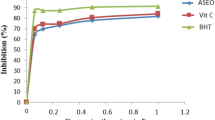Abstract
Endrin depletes glutathione levels and induces lipid peroxidation in various species of animals. We have, therefore, examined the effect of antioxidants on these parameters in endrin-treated rats. Butylated hydroxyanisole (BHA), vitamin E, vitamin C, and the glutathione precursor cysteine significantly inhibited hepatic glutathione depletion and lipid peroxidation induced by 4 mg endrin/kg body weight. Furthermore, these antioxidants provided partial protection against lethality produced by 8 mg endrin/kg body weight. These results suggest but do not prove that free radical-mediated lipid peroxidation and glutathione depletion may be involved in the toxic manifestations of endrin.
Similar content being viewed by others
References
Antunes-Madeira BC, Madeira VMC (1979) Interaction of insecticides with lipid membranes. Biochem Biophys Acta 550:384–392
Baltzinger RP, Ou SYL, Beuding E (1978) Antimutagenic effects of 2(3)-tert-butyl-4-hydroxyanisole and of antimicrobial agents. Cancer Res 38:4478–4485
Bandyopadhyay SK, Tiwari RK, Bhattacharyya A, Chatterjee GC (1982) Effect of dieldrin on rat liver plasma membrane enzymes. Toxicol Lett 11:131–134
Beuge JA, Aust SD (1978) Microsomal lipid peroxidation. Meth Enzymol 51:302–310
Boyland E, Chasseaud LF (1969) The role of glutathione and glutathione S-transferases in mercapturic acid biosynthesis. Adv Enzymol 32:173–219
Bus JS, Gibson JE (1979) Lipid peroxidation and its role in toxicology. In: Hodgson E, Bend JR, Philpot RM (eds) Reviews in Biochemical Toxicology, Vol I, Elsevier/North Holland, New York, pp 125–149
deToranzo EGD, Marzi A, Castro JA (1981) Effects of cysteine and cystamine on the carbon tetrachloride induced decrease in arachidonic acid content of rat liver microsomal phospholipid. Toxicology 19:72–82
Donovan DH, Williams SJ, Charles JM, Menzel DB (1977) Ozone toxicity: Effect of dietary vitamin E and polyunsaturated fatty acids. Toxicol Lett 1:135–139
Ellman GL (1951) Tissue sulfhydryl groups. Arch Biochem Biophys 82:70–77
Hassan MQ, Murray WJ, Stohs SJ (1985) Inhibition of TCDD-induced lipid peroxidation, glutathione peroxidase activity and toxicity by BHA and glutathione. Bull Environ Contam Toxicol 34:787–796
Hawk PB (1965) In: Oser BL (ed) Hawk's Physiological Chemistry. The Blakiston Division, McGraw-Hill, New York, p 147
Hocman G (1988) Chemoprevention of cancer: Phenolic antioxidants (BHT, BHA) Int J Biochem 20:639–651
Kahl R, Wulff U (1979) Induction of rat hepatic epoxide hydratase by dietary antioxidants. Toxicol Appl Pharmacol 47:417–427
Kato N, Kawai K, Yoshida A (1981) Effect of dietary level of ascorbic acid on the growth, hepatic lipid peroxidation, and serum lipids in guinea pigs fed polychlorinated biphenyls. J Nutr 111:1727–1733
Kulkarni AP, Hodgson E (1980) In: Hodgson E, Guthrie FE (eds) Introduction to Biochemical Toxicology. Elsevier, New York, pp 341–356
Lowry OH, Rosebrough NJ, Farr WL, Randall RJ (1951) Protein measurement with the folin-phenol reagent. J Biol Chem 193:265–275
Metcalf RL (1971) The chemistry and biology of pesticides. In: Whitestevens R (ed) Pesticides in the Environment. Vol. 1, part 1., Marcel Dekker Inc, New York, pp 1–144
Miranda CL, Reed RL, Cheeke PR, Buhler DR (1981) Protective effects of butylated hydroxyanisole against the acute toxicity of monocrotaline in mice. Toxicol Appl Pharmacol 59:424–430
Mitchell JR, Hinson JA, Nelson SD (1976) Glutathione and drug-induced tissue lesions. In: Arias IM, Jakoby WB (eds) Glutathione Metabolism and Function. Raven Press, New York, pp 357–367
Numan IT, Hassan MQ (1989) Endrin-induced lipid peroxidation. Iraqi Pharmacol J (in press)
Perrissoud D, Testa B (1982) Hepatic pharmacology: Mechanisms of action and classification of amtinecrotic hepatoprotective agents. Trends Pharmacol Sci 3:365–367
Rahimtula AD, Jernstrom B, Dock L, Moldeus P (1982) Effects of dietary andin vivo 2(3)-t-butyl-4-hydroxyanisole and other phenols on hepatic enzyme activities in mice. Brit J Cancer 45:935–944
Reddy CC, Scholz RW, Thomas CE, Massaro EJ (1982) Vitamin E dependent reduced glutathione inhibition of rat liver microsomal lipid peroxidation. Life Sci 31:571–576.
Robertson LW, Andres JL, Safe SH, Lovering SL (1983) Toxicity of 3,3,4,4,- and 2,2,5,5-tetrabromobiphenyl: Correlation of activity with aryl hydrocarbon hydroxylase induction and lack of protection by antioxidants. J Toxicol Environ Hith 11:81–91
Rodwell VW (1983) Biosynthesis of amino acids. In: Martin DW, Mayeis QA, Rodwell VW (eds) Harpers Review of Biochemistry. Middle East Edition, Beirut, Lebanon, pp 270–271
Saffiotti U, Terracini D (1974) Endrin IARC Monograph 5:157–171
Sagai M, Tappel AL (1978) Effect of vitamin E on carbon tetrachloride induced lipid peroxidation as demonstrated byin vivo pentane production. Toxicol Lett 2:149–155
Tappel AL, Zalkin H (1959) Lipid peroxidation in isolated mitochondria. Arch Biochem Biophys 80:326–332
Author information
Authors and Affiliations
Rights and permissions
About this article
Cite this article
Numan, I.T., Hassan, M.Q. & Stohs, S.J. Protective effects of antioxidants against endrin-induced lipid peroxidation, glutathione depletion, and lethality in rats. Arch. Environ. Contam. Toxicol. 19, 302–306 (1990). https://doi.org/10.1007/BF01054969
Received:
Revised:
Issue Date:
DOI: https://doi.org/10.1007/BF01054969




